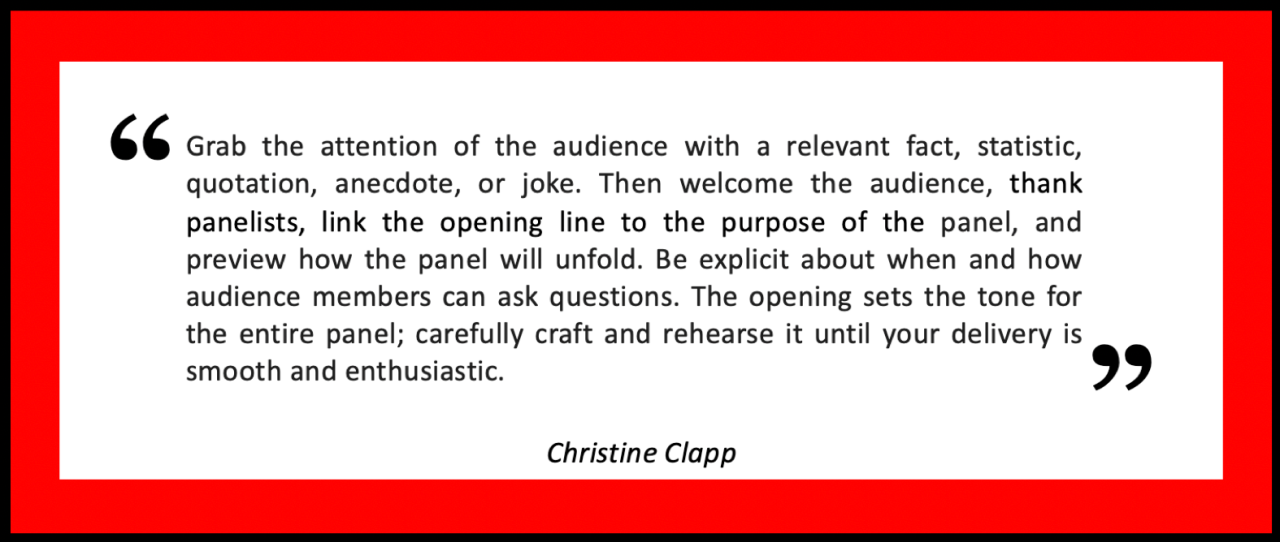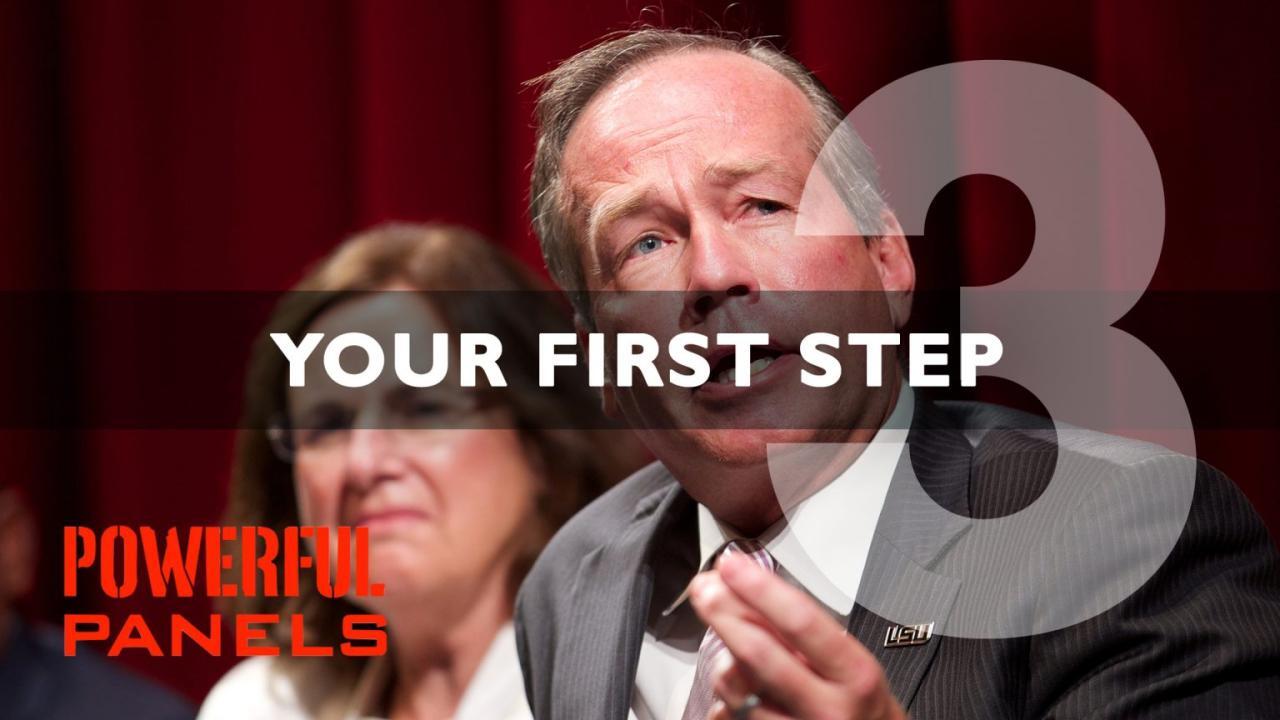Panel discussions offer a dynamic platform for exploring complex topics, fostering insightful dialogue, and engaging diverse perspectives. Successfully moderating a panel discussion requires a keen understanding of the process, from defining the topic to handling challenging situations. This guide will equip you with the knowledge and strategies to lead a productive and memorable panel discussion.
This comprehensive resource delves into the critical aspects of panel discussion moderation, covering everything from selecting the perfect panelists to managing time effectively and addressing potential conflicts. It provides a practical framework for preparing, executing, and evaluating your panel discussion, ensuring a smooth and enriching experience for all participants.
Assembling the Panel
A panel discussion’s success hinges significantly on the composition of its members. Careful selection of panelists ensures a rich and engaging exchange of ideas, fostering a productive and insightful discussion for the audience. The ideal panel balances expertise, experience, and diverse perspectives to provide a comprehensive and nuanced understanding of the topic at hand.
Essential Characteristics of Panel Members
Effective panel members possess several key characteristics. They are knowledgeable about the subject matter, articulate in their communication, and respectful of differing viewpoints. Furthermore, they are adept at engaging in constructive dialogue, fostering a collaborative atmosphere, and maintaining a professional demeanor throughout the discussion. These qualities are crucial for maintaining a high level of intellectual discourse and a positive overall experience for both panelists and attendees.
A lack of any of these characteristics can significantly impact the overall quality and effectiveness of the panel discussion.
Types of Panel Members
Panel discussions often benefit from a mix of different types of members. Experts, possessing deep knowledge and research in a specific field, bring valuable insights based on their academic or professional studies. Practitioners, individuals with hands-on experience in the field, provide real-world perspectives and practical applications of the discussed concepts. Advocates, who passionately champion a particular viewpoint or cause, add emotional depth and different points of view to the conversation, often challenging established norms or assumptions.
The optimal panel composition balances these types of members, offering a rich tapestry of viewpoints.
Selecting Panel Members for Purposeful Discussion
The selection process should be directly aligned with the discussion’s intended purpose. For example, a panel discussing the future of renewable energy should include experts in the field, alongside practitioners with experience in implementing renewable energy projects, and advocates for environmental sustainability. Considering the specific goals and target audience for the discussion will help ensure the chosen panel members can effectively contribute to the desired outcomes.
This method of selection will help to ensure a balanced panel with members that are able to discuss the issues from multiple viewpoints.
Importance of Diverse Perspectives
A panel discussion thrives on a diversity of perspectives. Including individuals with different backgrounds, experiences, and viewpoints fosters a more comprehensive understanding of the topic. For example, a panel on global trade should include representatives from various countries, representing different economic situations and cultural contexts. This broadens the discussion’s scope and depth, making the insights more relevant and insightful for the audience.
Benefits of Including Diverse Backgrounds and Experiences
The inclusion of individuals with varied backgrounds and experiences yields several benefits. It broadens the range of insights and opinions presented, leading to a more nuanced and complete understanding of the topic. Different experiences can reveal unforeseen challenges or opportunities, contributing to a more holistic view of the subject matter. Moreover, it fosters inclusivity and demonstrates a commitment to understanding diverse viewpoints.
This will create a more engaging and thought-provoking experience for all attendees.
Panel Member Roles and Responsibilities
| Role | Responsibilities |
|---|---|
| Moderator | Facilitates the discussion, manages time, ensures all panelists have an opportunity to speak, and maintains a respectful and engaging environment. They also steer the discussion toward the pre-determined goals and address any disruptive behavior. |
| Panelist 1 (Expert) | Provides in-depth knowledge and insights based on research and studies. Offers a theoretical perspective, contributing to a deeper understanding of the topic. |
| Panelist 2 (Practitioner) | Offers practical application of concepts, highlighting real-world experiences and challenges. Provides insights into implementation strategies, contributing a grounded perspective. |
Preparing for the Discussion

Thorough preparation is key to a successful panel discussion. This involves meticulous planning, anticipating potential challenges, and ensuring all participants feel comfortable and respected. A well-structured discussion, guided by engaging questions and managed effectively, will lead to a productive and insightful exchange of ideas.Effective preparation allows moderators to navigate potential difficulties and guide the discussion towards a fruitful outcome.
This includes crafting thought-provoking questions, scheduling sufficient time for each segment, and establishing a clear protocol for addressing technical issues. A robust plan for handling potential conflicts or miscommunications is essential to maintaining a positive and productive environment for all involved.
Organizing Potential Discussion Questions
Developing a comprehensive list of discussion questions is crucial for a dynamic and thought-provoking panel discussion. These questions should be open-ended, prompting insightful responses and encouraging active participation from all panelists. The questions should be aligned with the overall theme of the discussion and should foster a collaborative environment.
- To stimulate engaging and insightful responses, questions should be formulated to encourage a range of perspectives. Examples include questions that encourage comparison, analysis, and personal experiences.
- Questions should be focused on the core themes of the discussion, allowing for in-depth exploration of each topic.
- The questions should be phrased in a neutral manner, avoiding leading or biased language. For instance, avoid questions that imply a specific answer or point of view.
Creating Engaging Discussion Questions
Creating compelling discussion questions is a critical aspect of facilitating a successful panel discussion. These questions should be open-ended, encouraging thoughtful responses and stimulating debate.
- Avoid yes-or-no questions. Instead, ask questions that encourage detailed answers, fostering a more comprehensive and insightful discussion. For example, instead of “Do you agree with X?”, ask “What are the key factors influencing your perspective on X?”
- Encourage diverse viewpoints by formulating questions that promote a range of perspectives. This can involve posing questions that encourage comparison, contrast, and the sharing of personal experiences.
- Questions should be focused and relevant to the topic at hand. This ensures that the discussion remains on track and addresses the key themes of the panel.
Managing Time Effectively
Effective time management is essential to ensure a smooth and efficient panel discussion. A clear understanding of the allotted time for each segment and each participant is crucial.
- Divide the allotted time for each participant and topic based on the importance and complexity of the points. This ensures that all relevant issues are covered within the available time frame.
- Establish clear time limits for responses to questions, and for each segment of the discussion. This helps to keep the discussion on track and avoids unnecessary delays.
- A well-structured schedule, clearly outlining the time allocated for each segment, will prevent the discussion from exceeding the allotted time.
Logistical Preparations
Careful logistical preparation is essential for a successful panel discussion. This includes meticulous planning for technology setup, participant accommodations, and other practical considerations.
- Confirm all necessary technology, including microphones, cameras, and internet connectivity, is functioning correctly prior to the event.
- Ensure that all participants have access to the necessary materials, including presentation slides or handouts, in advance of the discussion.
- Establish a clear protocol for handling technical issues or unforeseen circumstances.
Ensuring Participant Comfort and Respect
Creating a welcoming and respectful environment for all participants is paramount. This includes ensuring that each participant feels comfortable sharing their views and contributing to the discussion.
- Establish clear guidelines for respectful communication and debate. Encourage participants to listen attentively to each other and to avoid interrupting or personal attacks.
- Ensure all participants feel heard and valued, and provide ample opportunities for each person to share their perspective.
- A comfortable environment fosters productive discussions and ensures that each participant feels empowered to contribute meaningfully.
Potential Challenges and Mitigation Strategies
Anticipating and addressing potential challenges proactively is essential for a successful panel discussion. A well-defined plan for handling unexpected issues will contribute to a positive experience for all involved.
| Challenge | Mitigation Strategy |
|---|---|
| Technical difficulties (e.g., audio issues, internet outages) | Have a backup plan in place, including a secondary internet connection, a backup microphone, and a designated technician to address technical problems promptly. |
| Imbalance in participation (e.g., one participant dominating the discussion) | Establish clear time limits for responses and actively encourage participation from all panelists. If necessary, gently redirect the discussion to other participants. |
| Disagreements or conflicts among panelists | Encourage respectful dialogue and emphasize the importance of maintaining a civil and professional demeanor. If necessary, step in and redirect the discussion. |
Moderating the Discussion

The moderator plays a crucial role in orchestrating a productive and engaging panel discussion. Their skillful facilitation ensures that all voices are heard, the discussion stays focused, and the desired outcomes are achieved. A well-prepared moderator can transform a potentially chaotic exchange into a compelling and informative dialogue.
Guiding the Discussion
A moderator effectively guides the discussion by maintaining a clear focus on the topic. This requires anticipating potential tangents and steering the conversation back to the core issues. They must also ensure all panelists have ample opportunity to contribute, preventing one person from dominating the discussion. The moderator facilitates a dynamic exchange, ensuring a balanced and enriching flow of ideas.
Keeping the Discussion on Track
Maintaining the discussion’s focus is paramount. A well-defined agenda, circulated beforehand, serves as a helpful guide. If a discussion veers off topic, the moderator can gently redirect it, reminding participants of the central theme. Using transitional phrases, such as “building on that point,” or “returning to the initial question,” can subtly guide the conversation back to the main stream.
Prompting questions tailored to the specific topic can further refine the dialogue.
Managing Contributions
Handling diverse contributions effectively is vital for a successful discussion. Lengthy responses can be addressed by tactfully encouraging brevity, while ensuring the speaker’s points are well-understood. Side conversations should be acknowledged and briefly summarized before returning to the primary discussion. Active listening, and summarizing, are essential to keep the discussion from losing focus.
Active Listening
Active listening is not just about hearing what is said, but about understanding the speaker’s perspective. A thoughtful moderator listens attentively, reflecting back the speaker’s points to ensure comprehension and validate their ideas. This fosters a respectful environment where participants feel valued and understood. Careful note-taking during the discussion is also beneficial for managing the flow and ensuring every point is addressed.
Common Moderator Mistakes to Avoid
A moderator should avoid interrupting speakers mid-sentence, except in cases of blatant derailment or overly extended comments. Excessive questioning can also diminish the discussion’s flow. Similarly, favor balanced participation over rapid-fire questions, and avoid showing bias toward any panelist. Personal opinions should be kept strictly separate from the facilitation process.
Encouraging Participation
Encouraging balanced participation is crucial. A moderator must ensure every panelist has the chance to contribute and engage with others.
| Method | Description |
|---|---|
| Open-ended questions | Questions that invite a range of responses, rather than simple yes/no answers, foster broader participation. |
| Probing questions | Following up on initial responses with clarifying or expanding questions can draw out additional insights. |
| Summarizing and paraphrasing | Regularly summarizing and paraphrasing points, acknowledging each participant’s contribution, makes them feel heard and validated, thus encouraging more participation. |
| Acknowledging contributions | Explicitly acknowledging the contributions of each panelist, with phrases like “That’s an excellent point,” reinforces the importance of every voice. |
Handling Difficult Situations

Moderating a panel discussion successfully hinges on adeptly managing unexpected challenges. These situations, though potentially disruptive, offer opportunities for demonstrating leadership and maintaining a productive discourse. Anticipating potential difficulties and developing strategies for addressing them empowers moderators to steer the discussion toward its intended goals.
Managing Disagreements and Conflicts
Addressing disagreements constructively is paramount. If panelists clash, the moderator should remain neutral and impartial. A tactful approach involves acknowledging the differing viewpoints, encouraging respectful dialogue, and steering the conversation back to the central theme. For example, the moderator might suggest a pause for reflection, followed by a re-framing of the issue. By actively guiding the discussion and emphasizing shared goals, the moderator can help panelists move past their disagreements and continue contributing to a richer understanding of the topic.
Addressing Off-Topic Conversations
Maintaining focus is crucial. When panelists stray from the discussion’s central theme, the moderator should gently redirect the conversation. This might involve restating the discussion’s focus or posing a question that links the off-topic point back to the main topic. A subtle but firm approach, like rephrasing the initial question, can effectively steer the conversation back on track.
This should be done with sensitivity and tact, ensuring panelists feel heard and respected.
Managing Interruptions and Distractions
Handling interruptions effectively is a vital aspect of successful moderation. Whether from panelists or the audience, interruptions should be addressed calmly and efficiently. A simple statement like, “Thank you for that point, but let’s return to the question of…” can redirect the focus. In cases of persistent interruptions, the moderator may need to politely but firmly re-establish the discussion’s parameters.
This demonstrates control and maintains the flow of the discussion.
Handling Challenging Questions or Comments
Audience questions and comments can be insightful and thought-provoking, but some may be challenging. The moderator’s role is to address such comments respectfully and thoughtfully. Instead of dismissing the question, the moderator should acknowledge it and try to integrate it into the discussion, potentially by asking follow-up questions. This demonstrates engagement and ensures the audience feels their input is valued.
A well-crafted response, even to a difficult question, can turn a potential challenge into an opportunity to enrich the discussion.
Example Table of Difficult Situations and Responses
| Situation | Response |
|---|---|
| Panelists disagree strongly on a point | Acknowledge differing views, encourage respectful dialogue, re-frame the issue, emphasize shared goals. |
| Panelist veers significantly off-topic | Gently redirect the conversation back to the main theme; restate the discussion’s focus or link the off-topic point back to the central topic. |
| Persistent interruptions from the audience | Politely but firmly re-establish the discussion parameters, acknowledging the valid point while focusing on the agenda. |
| Challenging question from the audience | Acknowledge the question, integrate it into the discussion, and ask clarifying follow-up questions. |
Post-Discussion Evaluation

A successful panel discussion isn’t just about the event itself; it’s about continuous improvement. Post-discussion evaluation is crucial for understanding what worked well, identifying areas for enhancement, and ultimately shaping future events into even more impactful experiences for all participants. This process provides valuable insights that allow moderators to refine their techniques and panelists to enhance their contributions.Thorough evaluation allows for a deeper understanding of the panel’s strengths and weaknesses.
This knowledge empowers moderators and panelists to refine their approach, making future discussions more engaging and insightful.
Importance of Evaluating Panel Discussions
Evaluation provides a framework for assessing the effectiveness of the discussion and identifying areas needing improvement. This feedback loop is essential for ensuring future panel discussions are well-structured, engaging, and thought-provoking. It allows for adjustments in preparation, moderation techniques, and panel selection to optimize the outcome.
Key Factors for Assessing Discussion Effectiveness
Several key factors contribute to the success of a panel discussion. These include audience engagement, the quality of panelists’ contributions, the moderator’s ability to guide the discussion, and the overall flow of the conversation. Measuring these elements provides a comprehensive understanding of the discussion’s strengths and weaknesses.
Methods for Gathering Feedback
Collecting feedback from both panelists and the audience is vital for a complete evaluation. Surveys, questionnaires, and informal discussions can gather valuable insights. These methods offer diverse perspectives and aid in pinpointing areas for improvement.
- Panelist Feedback: Individual interviews or short questionnaires can solicit specific feedback from each panelist. This can focus on their experience with the discussion flow, the quality of questions posed, and the overall effectiveness of the moderation. For example, a short survey could ask panelists how prepared they felt, whether they had sufficient time to respond to questions, and whether they felt their views were adequately represented.
- Audience Feedback: Gathering audience feedback is crucial. This could involve using online polls, surveys, or even short exit interviews. The data collected should consider factors like the level of engagement, the perceived clarity of the discussion, and the overall satisfaction with the event. For example, an online poll could ask audience members to rate the discussion on a scale of 1 to 5, with questions concerning the presentation of information and the panelists’ responses.
Incorporating Feedback into Future Discussions
Actively incorporating feedback is key to continuous improvement. Analyzing the collected data will reveal patterns and trends. These insights can be used to refine future panel discussions. For example, if audience feedback consistently highlights a lack of clarity in the discussion’s flow, the moderator can adjust their questioning strategy to ensure a more coherent narrative.
Documenting and Archiving the Panel Discussion
Documenting the panel discussion provides a valuable resource for future reference and improvement. This includes recording the discussion, transcribing key points, and summarizing the overall feedback received. This record ensures that the lessons learned from the discussion can be applied to future panel events. This allows for a systematic approach to learning and improvement over time.
Best Practices for Post-Discussion Analysis
This table Artikels best practices for conducting post-discussion analysis.
| Practice | Description |
|---|---|
| Establish a Feedback Mechanism | Implement a clear system for gathering feedback from panelists and audience members. This could include online surveys, feedback forms, or even a designated feedback box. |
| Analyze Feedback Data | Thoroughly review the collected feedback to identify recurring themes, positive aspects, and areas for improvement. |
| Develop Actionable Strategies | Use the feedback analysis to develop concrete strategies for enhancing future panel discussions. This could involve adjusting the panel composition, modifying the discussion structure, or refining the moderation techniques. |
| Document and Archive | Maintain detailed records of the discussion, including recordings, transcripts, and feedback summaries. |
Conclusion

In conclusion, moderating a successful panel discussion demands careful preparation, proactive management, and a keen understanding of participant dynamics. By implementing the strategies Artikeld in this guide, you can ensure a stimulating exchange of ideas, productive interaction, and a rewarding experience for everyone involved. The key to success lies in understanding the nuances of the discussion format and applying effective moderation techniques.